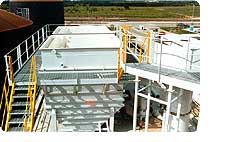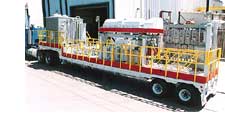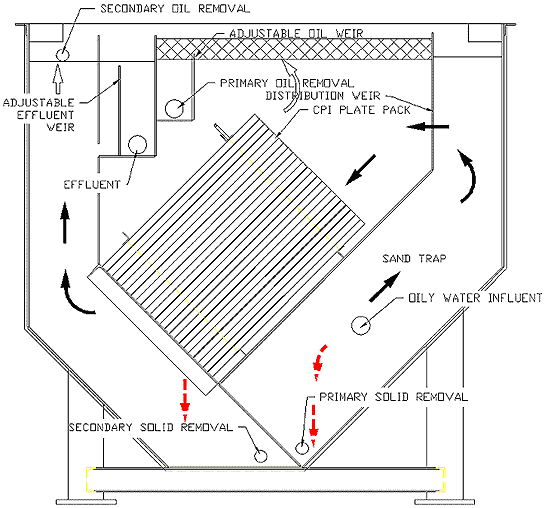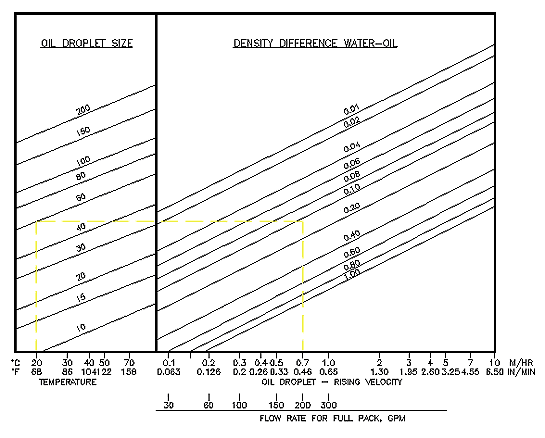 Separation of oil from water in industrial waste streams is an initial step to obtain permit level discharge. Efficient oil/water separation is of prime importance in industrial waste treatment stages often required before final discharge.
Separation of oil from water in industrial waste streams is an initial step to obtain permit level discharge. Efficient oil/water separation is of prime importance in industrial waste treatment stages often required before final discharge.  |
 |
 |
 Separation of oil from water in industrial waste streams is an initial step to obtain permit level discharge. Efficient oil/water separation is of prime importance in industrial waste treatment stages often required before final discharge.
Separation of oil from water in industrial waste streams is an initial step to obtain permit level discharge. Efficient oil/water separation is of prime importance in industrial waste treatment stages often required before final discharge. The HEI corrugated plate separator is a sophisticated, compact, highly efficient gravity settling basin designed to fill this need.
The basic design of the HEI corrugated plate separator
is shown below. When wastewater enters the separator inlet compartment,
the velocity is slowed, allowing large solids to settle out in the sand
collection compartment and large oil globules to float to the surface.
The influent then passes through a distribution baffle and enters the
plate pack compartment.
 After
passing through a quiescent zone, wastewater enters the corrugated
plate pack. Here the finer oil droplets and settable solids are
separated out by gravity. The de-oiled wastewater flows into the
effluent compartment and rises toward the effluent weir.
After
passing through a quiescent zone, wastewater enters the corrugated
plate pack. Here the finer oil droplets and settable solids are
separated out by gravity. The de-oiled wastewater flows into the
effluent compartment and rises toward the effluent weir. Both the plate pack compartment and effluent
compartment are provided with an adjustable weir. Height is adjusted to
balance the hydraulic loads so that only oil is skimmed off the surface
of the plate pack compartment. An oil layer is maintained in this
compartment and is automatically skimmed due to the difference in specific gravity of oil and water.
At the heart of the HEI corrugated plate separator
is the plate pack. The standard plate pack consists of fifty corrugated
plates spaced on 3/4" centers. A cutaway view is shown below.

The plate pack is designed so that oil, as it
separates from water, migrates to the underside of the plate above and
collects in the peaks of the corrugations. The migration continues
counter to the water flow toward the inlet of the plate pack. Sludge settles to the top of the next lower plate, collects in the valleys of the corrugations, and slides by gravity toward the outlet end of the plate pack.
The peaks of the corrugations at the inlet end are
connected by vertical gutters to guide the collected oil of of the
wastewater flow area. The same system is provided on the valleys at the
outlet end for sludge disposal. The collection gutter prevents the
re-entrainment of oil or sludge.
Design and Engineering Services |
HEI manufactures and sells fabricated steel
vessels housing the corrugated plate pack. Each unit is designed to
customer requirements and specifications.
At Hoffland Environmental.... we design, manufacture and install every system as though we were going to us it ourselves.
|
Advantages of the Corrugated Plate Separator |
-
No moving parts.
-
Low maintenance costs - unit seldom needs cleaning. However, cleaning can be done by hosing down with a high pressure hose.
-
Low operating costs - no power is required to operate unit.
-
Low space requirements - unit has a retention time of 3-10 minutes, while other settling devices require 1-10 hours.
-
Low capital expenditure.
Separator Applications |
-
Oil Production - Oil removal from produced water.
-
Oil Refineries - Oil and sludge removal from wastewater.
-
Petrochemical - Oil and solids removal from process streams and wastewater.
-
Water Treating Plants - Floc removal from clean water.
-
Steel Mills - Solids and oil removal from process water, cooling and wastewater.
-
Marine Terminals - Removal of oil spilled in transfer.
-
Truck Terminals - Removal of oil spilled in transfer.
-
Industrial Plants - Removal of oil and solids from wash down and wastewater.
Quick Sizing Chart |
The chart below illustrated the relationship
between capacity, particle size, temperature, and specific gravity for
the HEI corrugated plate separator.
Because the plate pack is a gravity type
separator, its efficiency is determined by the rising or settling
velocity of the smallest particles to be intercepted. The following
sizes may be used as design guidelines.
Runoff or Washdown 90 Micron
Industrial Waste Systems 60 Micron
Produced Water 40-50 Micron
Example: Given an industrial stream of 100 gpm at
68°F; specific gravity, water = .995; specific gravity, oil = .895
determine separator size required and actual 100% particle removal size.

Locate 68°F on the horizontal temperature scale of the chart below. Project vertically to intercept 60 microns on the particle size scale. Next, project vertically down to the through-put scale and read 150 gpm.
This is the maximum flow per pack for 100% 60
micron removal. Only one pack is needed then for 100 gpm. Now, starting
at 100 gpm project vertically to .1 differential. Next, project
horizontally to the temperature projection (68°F). Interpolate a micron
size of 50.
When operated at the above conditions a single plate pack unit will remove all free oil particles down to 50 microns.
